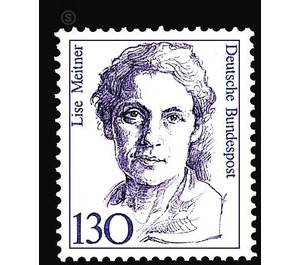Postage stamp: Women of German History - Germany / Federal Republic of Germany 1988 - 130 Pfennig
Theme: Health & Human
| Country | Germany / Federal Republic of Germany |
| Issue Date | 1988 |
| Face Value | 130.00 |
| Color | white violet |
| Perforation | K 14 |
| Printing Type | 2-color Typography |
| Stamp Type | Postage stamp |
| Item Type | Stamp |
| Chronological Issue Number | 1239 |
| Chronological Chapter | GER-BRD |
| SID | 571872 |
| In 48 Wishlists | |
With »Women of German History« the Deutsche Bundespost replaces the series »Industry and Technology« begun in 1975/76. The new series is intended to help raise awareness of women's achievements in society. The new 20 Pf and 130 Pf values appear simultaneously and identically in the issues »Deutsche Bundespost« and »Deutsche Bundespost Berlin«. Lise Meitner was born on November 7, 1878 in Vienna. In Vienna in 1906 she received the second doctorate in physics as the second woman. One year later, in 1907, Lise Meitner left Vienna to deepen her knowledge of Max Planck in Berlin. Here she meets Otto Hahn, almost the same age as her, a chemist who wins her work together. In 1926 Lise Meitner was appointed associate professor. In 1918, she received her own physical radioactive department at the Kaiser Wilhelm Institute in Berlin. For years she has devoted herself to the study of beta rays. Lise Meitner was baptized Christian, but her parents both had Jewish ancestors. She loses her teaching license in 1933, but continues to work for Hahn. As Austrian nationals she fled only with the Anschluss of Austria in 1938 rushed to Stockholm. After the neutron was discovered in 1932, Hahn and Meitner had been particularly interested in the search for transuranic elements heavier than uranium. As a result of years of joint radioactive work together with Fritz Straßmann, a few weeks after Lise Meitner's departure, Otto Hahn was able to detect surprisingly foreign chemical elements in the uranium samples irradiated with neutrons; the unexpected substances could only have come from the splitting of atomic nuclei, which until then had been thought to be indivisible. Shortly thereafter, Lise Meitner published the theoretical explanation for the physical process from Stockholm. The monstrous application of their research, recognized by others, was known to them soon after their discovery, but Otto Hahn and Lise Meitner were completely surprised by the rapid construction of a nuclear bomb. They were deeply shaken by the 1946 dropping on Japan. Both had high hopes for the peaceful use of atomic energy. After 1945, Lise Meitner Germany shook hands with reconciliation: "When I turn my back on political problems, my years spent in Germany were the best in my life." In 1960 Lise Meitner moved to Cambridge to become a nephew. There she dies, in the same year as Otto Hahn, on October 27, 1968 at the age of 89. (Text: Thomas Robertson, Hahn-Meitner-Institut, Berlin)


